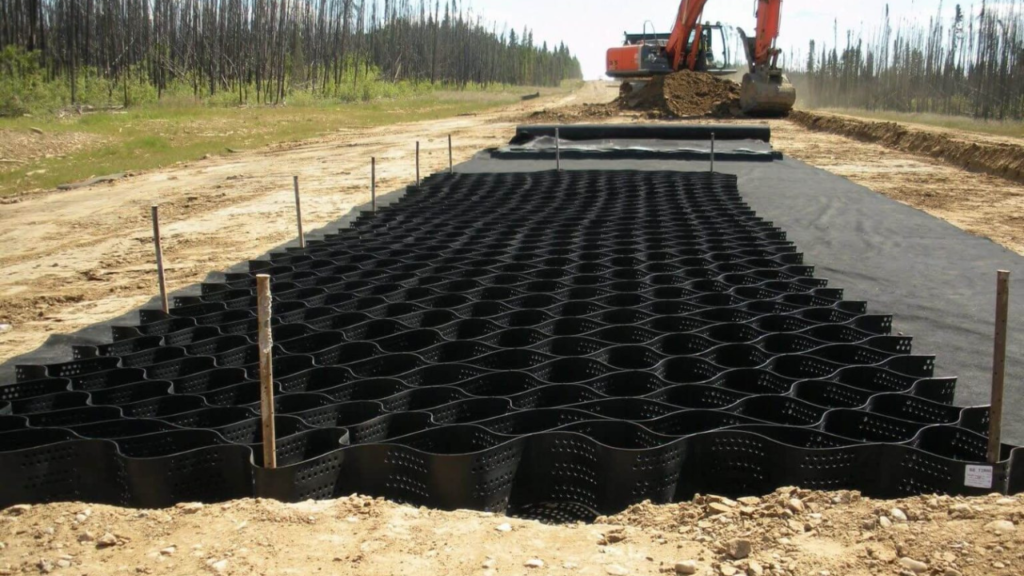In Nigeria, one of the most important steps before building a house is ensuring that the ground is stable enough to carry the structure.
Weak or unstable soil can lead to cracks, foundation failure, and even building collapse.
So, how do you stabilize the ground before laying the foundation?
In this article, Bullionrise consult will explore why Soil stabilization is necessary, the best methods used in Nigeria, and how to choose the right approach based on your soil type and project size.
Table of Contents
ToggleSee also – How do you solve foundation problems to avoid building collapse?

Why is Soil Stabilization Important?
Ground stabilization involves improving the strength and bearing capacity of the soil to support a building safely.
It is especially important when:
- The soil is loose, swampy, or waterlogged
- The building is multi-story or heavy
- The site is in a flood-prone or erosion-prone area
Without proper soil stabilization, the foundation may sink, crack, or shift, leading to structural damage.
Best Ways to Stabilize the Soil for Foundation in Nigeria
1. Excavation and Replacement (Soil Replacement Method)
This is one of the simplest methods, where weak topsoil is removed and replaced with compacted laterite, sharp sand, or gravel.
Excavation and replacement is best for:
- Small buildings like bungalows
- Sites with soft topsoil (e.g., clay or black soil)
Steps for good excavation and replacement
- Excavate 1–2 meters of weak soil
- Backfill with stronger material
- Compact layer by layer using a rammer or plate compactor
Advantages
- Affordable
- Easy to execute
Disadvantages
- Not ideal for very deep weak soils
See related – Which foundation is suitable for which soil?
2. Use of Hardcore and Compaction
Hardcore includes broken blocks, stones, gravel, or other strong materials laid and compacted to create a strong base.
Hardcore and Compaction is best for:
- Sites with shallow soft soil
- Areas needing solid base before pouring concrete
Steps for Hardcore and Compaction
- Spread layers of hardcore (150mm–300mm thick)
- Compact each layer thoroughly
- Finish with sharp sand blinding before foundation
Advantages
- Readily available materials
- Provides firm base
Disadvantages
- Doesn’t improve deep soil layers
3. Soil Stabilization with Cement or Lime
This involves mixing cement or lime with the soil to increase its load-bearing capacity.
Soil Stabilization with Cement or Lime is best for:
- Clayey or expansive soil
- Roads, low-rise buildings
Steps for Soil Stabilization with Cement or Lime
- Spread cement/lime over soil
- Mix thoroughly with the soil
- Add water and compact
Advantages
- Strengthens soil significantly
- Long-lasting effect
Disadvantages
- Slightly more technical
- Requires good mixing and curing
See related – How do you solve foundation problems to avoid building collapse?
4. Use of Geotextiles or Geogrids
These are synthetic materials placed between soil layers to reinforce the ground.
Use of Geotextiles or Geogrids is best for:
- Waterlogged or swampy areas
- Projects with weak soil or erosion risk
Steps used for Geotextiles or Geogrids
- Lay geotextile over the weak soil
- Add layers of gravel or sand
- Compact and build on top
Advantages
- Increases stability
- Prevents mixing of soil layers
Disadvantages
- Costly compared to simple methods
- Needs proper installation
5. Pile Foundations (Deep Ground Stabilization)
Instead of strengthening the soil, this method transfers the building load to deeper, stronger soil layers using piles (concrete or steel columns).
Deep Ground Stabilization is best for:
- High-rise buildings
- Swampy, coastal, or flood-prone areas
Steps for Deep Ground Stabilization
- Drill or drive piles deep into the ground
- Connect piles with reinforced concrete caps
- Build foundation on the caps
Advantages
- Ideal for very poor soil
- Extremely strong and stable
Disadvantages
- Expensive
- Requires heavy machinery and professionals
Recommended method
For Firm laterite soil Compaction, use of hardcore.
For Swampy or coastal area Pile foundation, use geotextiles.
For Clay or black soil, use Lime/cement stabilization or soil replacement.
When on low Budget, use Hardcore or shallow soil replacement.
For Multi-story building, use Piling or cement stabilization.
For Small bungalow, use Compaction with sand or laterite.
Conclusion
The best way to stabilize the ground for a foundation depends on the type of soil, type of building, and your budget.
Skipping ground stabilization is one of the major causes of foundation failure in Nigeria and it can cost millions to fix later.
Before building, always do a soil test and consult with a structural or geotechnical engineer to recommend the right method.
A solid foundation starts with solid ground.
Frequently asked questions
What are the common methods for stabilizing soil before constructing a foundation?
Common methods include soil compaction, adding stabilizing agents like lime or cement, and installing geotextiles.
Soil compaction increases density and load-bearing capacity, while lime or cement improves cohesion in loose soils.
Geotextiles provide reinforcement and prevent erosion or shifting.
These techniques are chosen based on soil type, construction needs, and environmental conditions.
How does soil compaction improve ground stability for foundation construction?
Soil compaction reduces air gaps, increasing the soil’s density and strength to support a foundation.
It minimizes settlement issues and enhances load-bearing capacity by creating a more uniform base.
Compaction is achieved using equipment like rollers, rammers, or vibratory plates.
Proper compaction ensures a stable and durable foundation for the building.
What role does drainage play in stabilizing the ground for a foundation?
Effective drainage prevents water accumulation around the foundation, reducing the risk of soil weakening or erosion.
Installing drains, sloping the land, or using gravel layers ensures water flows away from the site.
Good drainage maintains soil stability by controlling moisture levels and preventing waterlogging.
This is particularly important in areas prone to heavy rainfall.
Are chemical treatments effective in strengthening weak soil for foundations?
Yes, chemical treatments like adding lime, cement, or polymer additives can stabilize weak soils.
Lime reduces plasticity and increases strength in clayey soils, while cement improves cohesion and durability.
Polymers can bind soil particles, creating a stable layer for construction.
These treatments are often used in combination with other methods like compaction for optimal results.
Can geotechnical techniques like piling be used for ground stabilization?
Yes, geotechnical techniques like piling are effective for stabilizing weak or unstable ground.
Piles are driven deep into the ground to transfer building loads to stable soil layers or bedrock.
This method is commonly used in areas with loose or soft soil where shallow foundations are insufficient.
Piling ensures long-term stability and prevents settlement or shifting of the structure.







